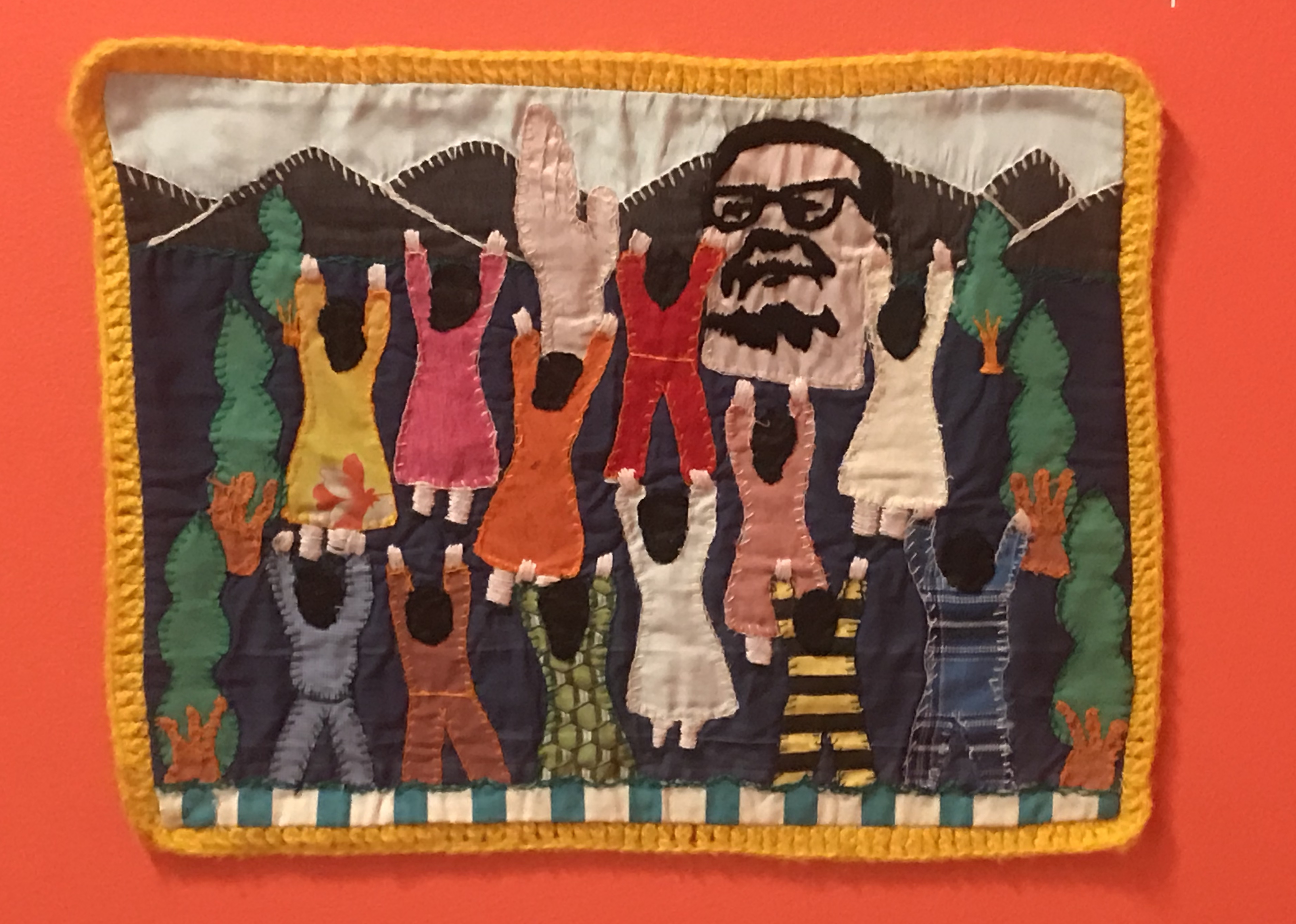At first glance, dozens of Chilean arpilleras—patchwork portraits on burlap canvasses—appear hopeful on display at the Museum of Latin American Art. Often depicting a beaming sun emerging from Andean mountaintops, the cheerful colors of stitched cloth sharply contrast with images of life under a brutal dictatorship: a presidential palace engulfed in flames, leftist activists dumped into the Pacific Ocean from military helicopters, book burnings and a boot stamping out press freedom.
“It was dangerous for Chilean women to create arpilleras but they were always working in spaces considered safe havens,” says Ana Maria Cobos, a retired Saddleback College librarian who helped organize the “Arte, Mujer y Memoria: Arpilleras From Chile 1973-1990” exhibit. “It’s a remarkable form that allowed women to express something that, typically, they wouldn’t have had the opportunity to.”

The small, rectangular textiles largely retell a story of death, that of Chilean democracy following the September 11, 1973 coup that ousted socialist president Salvador Allende and ushered decades of General Augusto Pinochet’s repressive reign. Weaving that history together, Chilean women made arpilleras in the sanctity of Catholic churches during the dictatorship, one keenly fearful of culture’s political prowess.
The right-wing press assailed the creations as “anti-Chilean” as sympathizers worked to smuggle them out of the country in support of the women artisans.
Cobos, who’s active with the Movimiento Pro-Emancipación de las Mujeres de Chile (MEMCh) in Los Angeles, gave brief history lessons at every stop during a recent tour of the exhibit with her family. Near the beginning of the exhibit, Cobos stopped at one arpillera and described it as the most personal to her.
The embroidered textile shows military men burning books beneath residential buildings where foreign leftists lived during Allende’s presidency. Cobos’ future husband tried to retrieve books for one such American friend following the coup; the effort cost him a week in detention.
Not all the images are as grim.
Others portray a community soup kitchen and a church workshop on how to make arpilleras. Soon, public outrage with the dictatorship took the form of protest before a plebiscite in 1988 spelled the end of Pinochet’s rule; a history faithfully recounted in the artwork displayed at the museum.
Most on exhibit are credited anonymously and come from the personal collection of Venice-based artist Francisco Letelier, son of the late Chilean diplomat Orlando Letelier who died in a Washington D.C. car bombing orchestrated by Pinochet’s secret police in 1976.
“My collection is a subset of a collection created by my mother Isabel Morel Letelier during the dictatorship with groups of arpilleristas,” says Letelier. “It aimed to create a chronology of events during the Pinochet era in order to highlight human rights abuses and the daily life of people in the country.”
With the help of the Vicariate of Solidarity, a human rights group in Chile run by the Catholic Church, arpilleras made their way north where they found a new political context in the exile community, particularly for women.
“Arpilleras became a very North American story as well, a fact often overlooked by American journalists and others,” Letelier adds. “The connection to struggles in Chile was often the lifeline and mechanism through which Chileans displaced to foreign countries could find a semblance of hope and consequence, reject powerlessness and help those within the country. In her work, my mother had extensive contact with the group of Chilean exiled women here in Southern California.”

Together, exile groups like MEMCh helped make arpilleras a subversive transnational cottage industry all while exploring the interplay between human rights and culture.
Inheriting such history, Cobos recently came to be involved with MEMCh-LA with an archivist mission in mind. She originally emigrated to the United States in 1965 as a young girl years before the coup. Along with a colleague from a similar background, Cobos helped to donate fifty arpilleras to Chile’s Museum of Memory and Human Rights in April, many belonging to Letelier.
The group hoped to retrieve them for the exhibit when social protests in Chile erupted in October over a metro fare hike, one that quickly escalated into a demand for the country’s current right-wing president Sebastian Piñera to resign. Historic marches have called for the adoption of a new constitution not burdened by Pinochet-era baggage.
Fortunately, MEMCh-LA had a backup plan in light of the unrest.
With culture playing a powerful role in current protests, an exhibit of arpilleras is as relevant as ever. It ends with “For the Right to Live With Dignity,” a modern embroidered textile by artist Victoria Diaz that presages the protests. The artwork critiques Chile’s consumer culture through the flow of privatized water, a common denunciation of past arpilleras.
With much work still to be done, Cobos’ group plans to patch a quilt together from arpilleras they will make later this month. They also hope to incorporate as a nonprofit and travel with the exhibit.
“Not only are we going to try to take this to other venues in Southern California, but we are going to give MEMCh a new life,” she says. “Now, there’s a very active group of women creating art as a result of what’s going on in Chile. Things change, and yet they don’t.”
Arte, Mujer y Memoria: Arpilleras From Chile exhibits at the Museum of Latin American Art through March 29; 628 Alamitos Ave.

